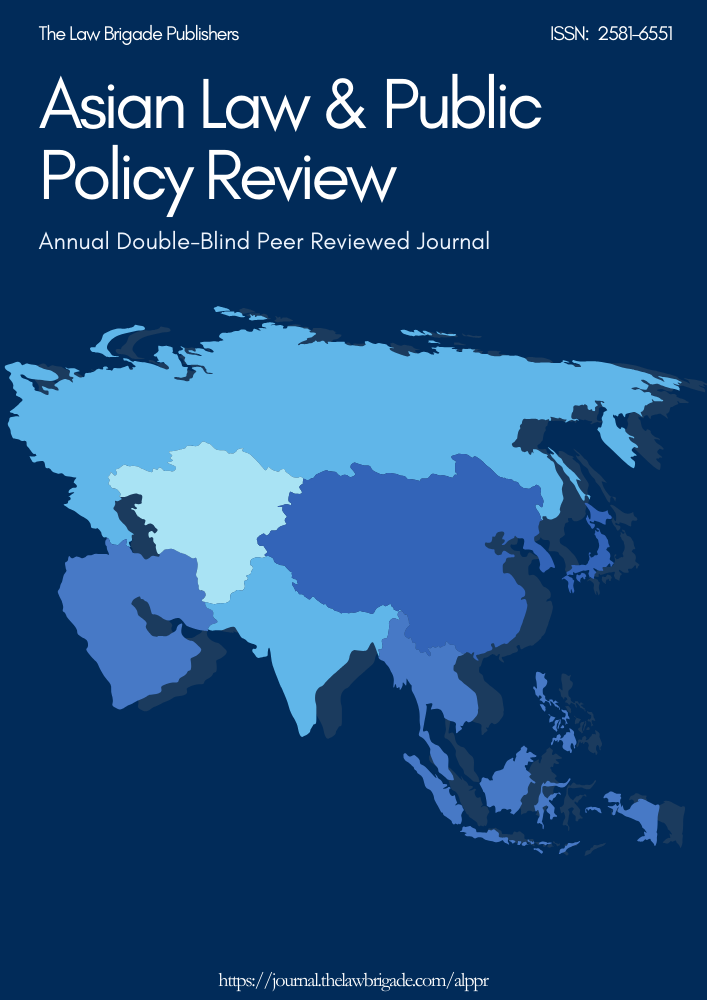HUMAN RIGHTS VIOLATIONS BY POLICE IN INDIA: A COMPARATIVE CASE STUDY
Keywords:
Human Rights, Police violations, India, DemocracyAbstract
Custodial Death or Arrest-Related Death refers to the death of a detainee while in police or judicial custody, prison and extends to any harm done during the process of detaining a suspect or accused. When a State takes away the personal liberty of a person, they should hold complete responsibility for the life and physical integrity of that person. Whether it’s the police custodies in India or all the way to the west in Minnesota, unlawful or excessive use of force by the police has been more prevalent than ever, this torture does not limit to just physical but also extends to mental and sexual torture. In this paper we’ve analysed the Indian Legal System’s evolution and present situation regarding this issue, we also dealt with the Human Rights Violations with the help of statistics. These cases are not restricted to a Geographical area with high police influence and uneducated or poverty-stricken people, even evolved nations such as the US are not immune to this problem, reminding us the statement “The US is a third world country wearing a Gucci belt.” Further in this paper, a detailed analysis of “George Floyd” and “Jayraj and Bennicks” cases along with a comparative analysis has been made, which occurred in the same timeline. We have taken into consideration the Legislative, Judicial and also the public involvement while studying the actions being taken post these unfortunate events. This paper is concluded by mentioning various recommendations and measures from Human Rights Commissions and Judiciary and also our personal suggestions.
Downloads
References
iv Law Commission, Implementation Of ‘United Nations Convention Against Torture and Other Cruel, Inhuman
and Degrading Treatment or Punishment’ Through Legislation, Government of India (2017)
vAbhigya R, Custodial violence: Indian Perspective, LEGAL SERVICES INDIA (August 10, 2020, 11:40 p.m)
http://www.legalserviceindia.com/legal/article-55-custodial-violence-indian-perspective.html
viArpan Rai, ‘Our George Floyds’: Outrage at custodies of Tamil Nadu, HINDUSTAN TIMES, June 28,2020,
at pg.1.
vii G.S. Bajwa, Human Rights in India: Implementation and violation, 1995.
viii Amnesty International Report, 1980.
ix Munna v. State of U.P. A.l.R. 1982 S.C. 806. (India).
x Anmesty International, The Impact of Violence against Women (2001).
xi
Amnesty International, India: Torture, Rape and Deaths in Custody Pg.8 (1992).
xii Convention against Torture and other Cruel, Inhuman or Degrading Treatment or Punishment, Article 2(1),
(1984).
xiii National Human Rights Commission, Annual Report, P.15. (1995-96).
xiv NHRC, Monthly Human Rights Cases Statistics from January to December 2019 (2020),
https://nhrc.nic.in/complaints/human-rightcase-statistics.
xvNCAT India, Annual Report on Torture 2019 (June 26 2020) http://www.uncat.org/wpcontent/uploads/2020/06/INDIATORTURE2019.pdf.
xvi Ibid
xvii NCRB, Crime in India 2018, ‘Custodial Crimes & Complaints Against Police Personnel’, (2019)
http://ncrb.gov.in/StatPublications/CII/CII 2018/Tables.html
xviii Ibid
xix (1994) AIR 1349.
xx A.l.R. 1930 Lah 945.
xxi AI.R. 1932 Lah 13.
Downloads
Published
Issue
Section
License

This work is licensed under a Creative Commons Attribution-NonCommercial-ShareAlike 4.0 International License.
License Terms
Ownership and Licensing:
Authors of research papers submitted to any journal published by The Law Brigade Publishers retain the copyright of their work while granting the journal specific rights. Authors maintain ownership of the copyright and grant the journal the right of first publication. Simultaneously, authors agree to license their research papers under the Creative Commons Attribution-ShareAlike 4.0 International (CC BY-SA 4.0) License.
License Permissions:
Under the CC BY-SA 4.0 License, others are permitted to share and adapt the work, even for commercial purposes, provided that appropriate attribution is given to the authors, and acknowledgment is made of the initial publication by The Law Brigade Publishers. This license encourages the broad dissemination and reuse of research papers while ensuring that the original work is properly credited.
Additional Distribution Arrangements:
Authors are free to enter into separate, non-exclusive contractual arrangements for distributing the published version of the work (e.g., posting it to institutional repositories or publishing it in books), provided that the original publication by The Law Brigade Publishers is acknowledged.
Online Posting:
Authors are encouraged to share their work online (e.g., in institutional repositories or on personal websites) both prior to submission and after publication. This practice can facilitate productive exchanges and increase the visibility and citation of the work.
Responsibility and Liability:
Authors are responsible for ensuring that their submitted research papers do not infringe on the copyright, privacy, or other rights of third parties. The Law Brigade Publishers disclaims any liability for any copyright infringement or violation of third-party rights within the submitted research papers.


